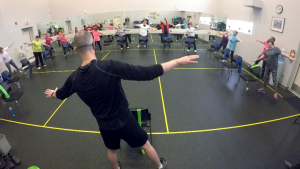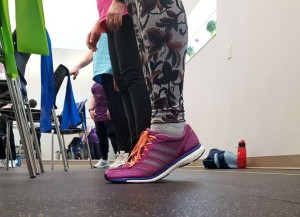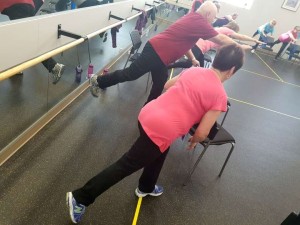Fitness instructor gives seniors a healthy fear of falls, then helps prevent them
February 4, 2018
Originally published by CBC
Close to 90 people die, 1,600 are hospitalized because of falls in Winnipeg every year, health authority says
Winnipeg fitness instructor Andrew Schindle hopes his students walk away from his class with a healthy fear of falling.
That’s part of the message he imparted during a class last Tuesday a Charleswood seniors centre, where more than a dozen people were gathered to practice movements most people do every day without thinking.

While Aretha Franklin’s raucous cover of The Beatles’ Eleanor Rigby blasted over the speakers, Schindle led the seniors through a routine designed to increase their strength and balance, with the aim of helping prevent falls.
“I want people to know that it is a real risk. Maybe they come in not afraid of falling, and maybe when I inform them, they have a healthy fear of falling,” Schindle said.
“Older adults are getting injured just from daily activities — bending over to pick something up, going up and down the stairs.”
Falls can cause serious injuries, leading to hospitalization, permanent loss of mobility or even death.
To counter that, the students in Schindle’s “functional movement” class work on their strength and flexibility, as well as balance exercises. They swing their arms, stand on their tiptoes and perch on one leg, training their bodies and keeping them in shape so they can continue doing the things they enjoy.
Linda Schroeder, 67, and her husband signed up for the class because they plan to take a trip to India, and they were told they should expect to do a lot of walking up and down stairs.
“I just find that my reaction time to catch myself — if I’m almost missing that step or [in] an icy situation outside — I find that just being able to keep my stability is keeping me from falling,” Schroeder said.
John Logan, 68, once fell while walking his dog in the winter. Although he wasn’t seriously injured, he was sore for a long time.
He said after taking Schindle’s class, he’s less likely to fall like that again.
“You can save yourself from falling or if you do fall, you’re quicker to brace yourself, when before you’d just fall on your back [and wouldn’t] even think about doing a proper movement.”
One of the main exercises Schindle teaches his students is standing on one leg for 30 seconds, then doing the same on the other leg, once every day until they can stand steadily on each leg.
“The balance-specific training, how that works when you do a balance exercise [is] your brain accumulates information on your body’s position, location and orientation. And then your brain, it automatically consolidates that information and your balance improves,” he said.
Fall-related deaths increasing
According to the Winnipeg Regional Health Authority, about 90 people die from fall-related injuries every year, and about 1,600 people are hospitalized.
Adults over the age of 65 are at an increased risk of fall-related injuries, particularly to the hips, head and wrists, Schindle said. As people age, their muscles deteriorate, nerves become disconnected, and the brain’s perception of the body’s orientation in space becomes weaker.
The number of deaths related to falls among older adults is rising, and not just because the proportion of seniors in the Canadian population is increasing, said University of Manitoba kinesiology professor Jonathan Singer.
To illustrate this to his students, Singer likes to compare graphs showing the rate of deaths related to motor vehicle accidents to the rate of deaths related to falls. While the graph for vehicle-related deaths shows a steady decline, there is a steady uptick in the number of deaths related to falls.
This trend persists even when the increasing number of seniors in the population is accounted for, Singer said.
Singer studies the neurological mechanism involved in maintaining balance. Although researchers have made progress in understanding why older adults experience more falls, Singer says there is still a lot we don’t know.
He compares the body’s balance-control system to a “black box.”
“We don’t really know what goes on inside,” he said. The system takes input from the sensory organs — eyes, ears, skin, etc. — and then the body’s motor system uses that information to adjust the body and maintain balance.
“So the sensory information that comes in is sometimes misinterpreted by the brain,” Singer said.
“Sometimes visual information is given priority over other types of information that may be more accurate, and so individuals will have errors in their movements.”
Older adults also experience a deterioration in their reactive control systems that can cause them to suddenly lose balance.
“The thing that differentiates somebody who falls from somebody who doesn’t, I think, is mostly their ability to restabilize in the face of that external balance-control challenge.


Learning to fall
In the Netherlands, one specialist is taking things a step further — teaching seniors not just how to prevent falls, but how to fall safely.
“You fall safe when you make your body round, like a ball. When you stick out your arm or your hip, you have the risk that the impact is so high that you could break it,” said Diedeke van Wijk, a Dutch physiotherapist who teaches fall safety courses three times a year.
To help people get over their fear of falling, van Wijk has her students practise falling onto thick mats.
“So you want the people to roll from their knee to their hip to their shoulder and then keep up their head so they don’t get an injury.”
Nearly 3,900 people over the age of 65 die from fall-related injuries each year in the Netherlands.
The impacts of falling go beyond the injuries caused by the fall itself, van Wijk said.
“You get anxious to fall again. You think twice before you go outside because you think ‘I could fall’ … so you stay inside and when you practise less, you will fall more.”
Those concerns come up in a winter city like Winnipeg, too. Schindle recounts an incident involving one of his students in another class, who fell on a sidewalk along Henderson Highway on a mild winter day. She was stuck for more than an hour, getting splashed by passing cars, before someone came along and helped her.
Now, Schindle says that student is reluctant to go outside, afraid she will fall again.
Long recovery times and loss of mobility from fall injuries can lead to other health problems that are not directly related to the initial injury.
“It’s sort of a chain reaction — one thing leads to the next and there are health complications that are related to that fall,” Schindle said. “It starts the chain reaction.”
He sees his fitness class as part of a “holistic” approach to health.
“My approach to physical activity is to put it in context. You have physical health, social health, [and] mental, emotional and spiritual health,” he said.
Marlaine Marshall, 67, says Schindle’s class has made her think more about her surroundings, giving her peace of mind. It also helps her continue with other activities that keep her healthy.
“I’m a golfer, so I want to stay in shape so that when golf season comes around, I’m able to do that,” she said.
At the end of class, the students are smiling and sweating. After Schindle congratulates them on a good class, they walk out the door, a little looser and steadier on their feet.
Category: Falls Prevention, Adding Quality to Later Life Years, News